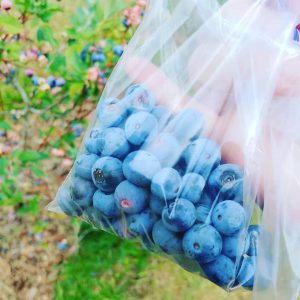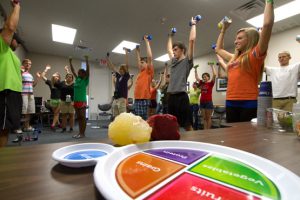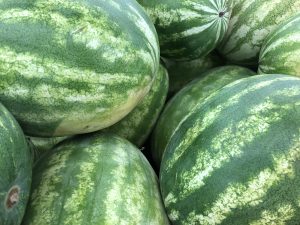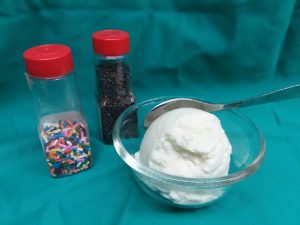
by Stephanie Herzog | Jul 25, 2019

Eating fresh, local produce is a great way to be healthier, save money, and support the local economy. (Photo source: Stephanie Herzog)
Summer Local Eats – Supporting Farmers’ Markets
Summer is a great time of year to eat locally grown fresh produce! There are many options rich in a variety of colors, shapes, sizes, and nutrients. Farmers work hard to provide life-sustaining sustenance for society, and consumers supporting their efforts at the local level has an array of health and economic benefits.
Fresh summer crops in the panhandle abound. Produce that is ready this time of year includes peppers, cucumber, peanuts, okra, squash, corn, and watermelon. Spice up a summer salad with fresh cucumbers or peppers or try tasty yellow meat watermelon for a chill and nutritious summertime snack! Local, fresh produce is a healthy alternative to processed foods or produce found in grocery stores. Produce sold by local farmers is freshly picked and because you know where it comes from, it is both safer to eat and keeps for longer periods of time than grocery store produce, which often has traveled long distances, is seldom inspected, and is kept in storage before finally being put out on the floor for purchase.
Supporting your farmers’ market benefits both you and your community in many ways. Purchasing from local farmers and farmers’ markets is both financially sound for you and is supportive of the community’s economy – the money changes hands locally and creates and maintains jobs. Not only does it benefit the economy, it also fosters a stronger sense of community unity and trusted relationships, which is vital to any successful society and local economy. For example, farmers will sometimes offer a “u-pick” program, depending on the crop, where you go to their farm and pick what produce you want right from the field! You get to keep half, and the farmer keeps half. This is a great cooperative effort that benefits everyone – you get free, fresh produce, and the farmer gets free labor. Who doesn’t love a win-win scenario?
Jackson County farmers’ markets information. Residents in Jackson County have a wonderful farmers’ market in the heart of downtown Marianna, located at Madison Street Park (2881 Madison St.) that goes throughout the summer every Tuesday, Thursday, and Saturday morning from 7am-12pm. After September, the market will continue through the fall, winter, and spring each Saturday at the same time. Tuesday and Thursday have farmer vendors only, while Saturday includes a variety of vendors, such as arts and crafts, plants and flowers, jams, jellies, honey, etc. This market also offers a raffle when you purchase items from vendors! For any questions about the market or how to join as a vendor, visit their Facebook page or contact Tony Mayo, the current farmers’ market manager or Terry Johnson, the public relations manager for the market. His number is 850-592-5114. It’s a good idea to bring cash or checks, but some vendors do accept credit and debit cards.
Want to find a farmers’ market near you or learn more about the benefits and best practices shopping at a farmers’ market?
Come experience the buzz and benefits of the farmers’ market!
Sources:
Local farmers at the Marianna City Farmers’ Market
Wang, Q., Evans, E. A., Pikarsky, M., & Olczyk, T. Consuming local vegetables from our local growers. UF IFAS publication HS1251.

by Dorothy C. Lee | Jul 21, 2019
Eating healthy is not something that just happens by going on a particular diet. In fact, the best kind of diet is where the right choices are made, and it becomes a way of life. Sometimes we need to know some ways to change the bad habits we have developed. There is no ‘quick fix’.

Tune Up Your Lifestyle
Photo Source: UF/IFAS
With today’s fast-paced lifestyles sometimes we feel we don’t have the time to do the things we know we should. For instance, to get more exercise, do things like park a distance from the store when you go shopping, walk up and down the stairs instead of taking the elevator, walk to lunch, or even turn up the speed on regular activities you perform around the house.
When grocery shopping choose foods from the basic food groups (fruits, vegetables, whole grains, lean protein, and reduced-fat dairy products) to round out a healthy meal plan.
Convenience foods are a part of today’s lifestyle, but they often lack nutritional quality, texture, and flavor. Preparing foods at home can be healthy and economical. You can boost nutrition and flavor by adding fresh herbs, spices, and aromatic vegetables to the meal menu.
Foods and beverages high in sugar add empty calories to the diet and contribute no nutritional value. Read labels to determine the amount of added sugar in food products. Choose lower calorie beverages.
Experiment with new food items. Try adding different fruits, vegetables, or grains to your diet. For example, try tropical fruits such as mango, guava, papaya, or grains as quinoa, barley, or millet, to add vitamins, minerals and fiber to the diet.
Before you go out to eat, don’t starve yourself. Drink water before the meal to avoid overeating or eat a snack before dinner and you won’t be tempted to overeat.
When socializing don’t meet at eating places. When you do dine out, cut out fried main dishes or ones with heavy sauces and gravies. Eat smaller portions and don’t go back for seconds. Order low-fat foods when possible. However, keep in mind that you too need to allow for indulgence along the way.
Be active! Physical activity has health benefits. Being physically active not only burns calories, it aids in physical strength, and cardiovascular health. U.S. Dietary Guidelines recommend being physically active at least 150 minutes a week for adults. (https://health.gov/dietaryguidelines/).
Chances are, along with a healthy diet and regular physical activity, your tune up will result in living a healthy lifestyle.
https://www.freshfromflorida.com/Consumer-Resources/Buy-Fresh-From-Florida/Tropical-Fruit
https://www.tropicalfruitgrowers.com/
For further information, contact:
Dorothy C. Lee, C.F.C.S.
UF/IFAS Extension Escambia County
3740 Stefani Road
Cantonment, FL 32533-7792
(850) 475-5230
dclee@ufl.edu

by jbreslawski | Jul 18, 2019

Photo source: UF/IFAS Northwest District
Have you noticed recently that there have been many sales on watermelon at your local grocery store and farmers’ markets and roadside stands have an abundant supply? That is because watermelon and July go together like peanut butter and jelly or bacon and eggs. This cool and refreshing fruit is now in season locally. Whether you like to spit seeds or prefer the seedless variety, this fruit is a healthy addition to your plate. Naturally low in sodium and calories, watermelon is an excellent source of vitamin A and can help keep you hydrated. It also is an excellent source of the antioxidant, lycopene (which gives the melon meat that pretty reddish-pink color). To select the best watermelon, look for one that is heavy for its size, has a uniform shape, and a dark, dull green color. A yellow spot on one side means that the fruit has been given time to ripen in the field and develop flavor.
Do not forget to give your watermelon a good rinse under cool water before slicing. Putting a knife through that melon can carry all of the bacteria from the rind and spread it onto the fruit. Since watermelon is not usually cooked, that means that bacteria will not be killed and you have a chance of getting a foodborne illness. Remember to do this with your cantaloupe and other melons too. Too much watermelon? Try serving watermelon in different ways like in a melon salad, or even in, or alongside, chicken salad. Watermelon should be refrigerated after being cut and can be frozen too. Use chunks of frozen watermelon in smoothies and other drinks too.
Here is a recipe for a bubbly, refreshing watermelon drink from Fresh From Florida to serve at your July picnic:
FLORIDA WATERMELON FIZZ
INGREDIENTS: 5 cups Florida watermelon (seeded and cubed); Florida honey, to taste; 2 cups sparkling water; one lemon, juiced; Fresh mint sprigs for garnish
PREPARATION: Add watermelon, honey, and lemon juice to a blender and process until smooth. Strain puree through a fine sieve or strainer. Fill four glasses with ice. Evenly distribute the strained juice into each glass. Top each glass with sparkling water and stir once. Garnish with fresh mint sprigs.
https://www.followfreshfromflorida.com/recipes/florida-watermelon-fizz/#

by Angela Hinkle | Jul 18, 2019
Cold and refreshing on a hot summer day. Official by presidential proclamation. It practically saved my life once. Behold – The Power of Ice Cream.
HISTORY
Some say the Chinese invented ice cream in the first century. Roman emperors are also credited with flavoring ice gathered from mountain tops. Still others say ice cream found its start in the areas of Iran or Ancient Greece. Regardless of its origins, ice cream was often only available to royalty who could afford the resources to make it. Once refrigeration/freezing became affordable, the popularity and availability of ice cream rose considerably. So now, most of us – royalty or not – can enjoy the Power of Ice Cream all year long.
THE 411
- Ice Cream is made with greater than 10% milkfat.
- Gelato is generally made up of 7%-8% fat.
- Soft serve has more air mixed in.
- Frozen Yogurt is usually lower in fat and is often available soft-serve style.
- Sherbet freezes a combination of fruit juice with milk, cream, egg white, or gelatin.
THE 911
Picture it. Moving day. One of the hottest, most humid days of the year. The kind of day that you feel like you’re walking around in really warm soup. Though I’m staying hydrated, after about four hours in, it hits me. I go into a fog and literally start to go down to the ground. Luckily, my dad is pretty quick on his feet for a big Sicilian man. He puts me in the shade and says, “Don’t move!’ To this day, I don’t know how he did it so fast, but within two minutes, he got me the best cold ice cream dessert ever. The world was quickly righted as was I. Though this is NOT normal emergency protocol, it’s my miracle ice cream story and I’m sticking to it.
COOL TIDBITS

A cool and refreshing sweet treat
Photo Source: Angela Hinkle
- The United States leads the way in ice cream consumption, eating or licking or drinking about 48 pints or 23 pounds a year.
- President Ronald Reagan declared July National Ice Cream Month. The third Sunday in July, this year July 21st, is National Ice Cream Day.
- Though boasting 31 flavors, Baskin Robbins’ most popular flavor is vanilla.
- Because acquiring vanilla was so difficult before the mid-1800s, vanilla ice cream was considered quite an exotic treat.
- Sometimes, because nerve endings on the roof of your mouth suddenly get cold from eating ice cream, your brain tells the blood vessels, “Contract!” When they go back to their normal size, blood rushes back in. And ooh, “ice cream headache.” One recommendation to prevent this “brain freeze” is to eat slowly. And a recommendation to stop it is to put your tongue up to the roof of your mouth. Nothing guaranteed – so good luck.
- 15%-20% of Americans say they eat ice cream in bed. For more interesting ice cream trivia, visit foodreference.com
BENEFITS
Though not a particularly nutrient dense food, ice cream does have some health benefits. The area of your brain called the orbitofrontal cortex – or pleasure center – is activated when people are happy. Eating ice cream has been identified with having an immediate “happy” effect on the brain. There is also calcium in ice cream, which is good for building strong bones and teeth. Question – should all your daily calcium come from ice cream? Answer – Um, No. Try to choose more calcium-rich foods that are lower in fat and sugar.
So, in moderation of course, enjoy the Power of Ice Cream!

Cold, Delicious, and so many flavors! Photo source: Lyndsey B.
See Below for two healthier ice cream options. Yum!
MyPlate Sundae
This recipe includes all five food groups.
Layer in a clear glass bowl, mug, or cup so you can see all the colorful layers.
- Dairy – Gelato or frozen yogurt – your choice of flavor
- Vegetable – Frozen sweetened rhubarb or cooked, mashed, and cooled sweet potato
- Fruit – Most any berry works great
- Grain – granola
- Protein – Sprinkle on your favorite nuts
Cool and Creamy Calcium Dreamy
Serves 3
Items needed
1 – gallon heavy-duty ziptop bag
1 – quart heavy-duty ziptop bag
rock salt
ice
Procedure – In the 1 quart bag add the following:
¼ cup pasteurized liquid eggs
1 cup fat-free milk
1 cup fat-free half and half
½ cup sugar
1 teaspoon vanilla flavoring
Zip the top closed. Put the 1-quart bag inside the gallon bag. Pack the gallon bag with ice and ¾ cup of rock salt. Close the top. Work the bag back and forth – rolling over and over or tossing back and forth for 15 minutes. It may help to have potholders or a dish towel to hold the bag, as it will get very cold. Drain the water off and stir your cool and creamy calcium dreamy. Repack the gallon bag with ice and rock salt and roll or toss for five more minutes.
Serve immediately with fresh local fruits and nuts. Enjoy!
For more about the dairy food group see https://www.choosemyplate.gov/dairy

by Kendra Hughson | Jul 9, 2019
It’s still the dog days of summer so it’s hard to believe that the first day of school is right around the corner. Soon, the kids will be wrapping up the lazy days of summer and the fun of summer camps and family vacations to prepare for the back to school routine. Making school supply shopping a special event helps children get excited and ready for the new school year. Back to school costs can add up so be sure to have a plan.

Plan ahead for back to school savings. Photo Credit: Kendra Zamojski
- Create a list of back to school supplies and clothes. Check with your local school for a current list of required school supplies. Remember to include clothes, shoes, sports equipment, extracurricular activity supplies, and other school fees. Inventory items that you may already have from the last school year. Identify what items might be outgrown or need to be replaced and note what items are still usable.
- Determine a budget and stick to it. Involve children in creating a budget and making purchasing decisions to help them learn financial management skills. Shopping with children is great time to talk about needs versus wants and how to make buying decisions to stay within a budget. Children might be able to contribute some of their own earned money to buy school supplies or clothing.
- Take advantage of the Back to School Sales Tax Holiday. The State of Florida has declared August 2 – 6, 2019 as a Back to School Tax Holiday. Eligible items include: Clothing, footwear, and certain accessories selling for $60 or less per item, certain school supplies selling for $15 or less per item, and Personal computers and certain computer-related accessories selling for $1,000 or less per item, when purchased for noncommercial home or personal use. For a complete list of eligible items visit the Back to School Tax Holiday site: https://revenuelaw.floridarevenue.com/LawLibraryDocuments/2019/06/TIP-122444_TIP_19A01-03_FINAL_RLL.pdf
- Many stores offer back to school sales and deals. Grab sales flyers and shop around for the best deals. Thrift stores and consignment shops are some other alternatives.
For more information, contact your local UF/IFAS Extension office: https://sfyl.ifas.ufl.edu/find-your-local-office/
For more information on back to school topics:
http://blogs.ifas.ufl.edu/franklinco/2018/08/02/back-to-school-survival-tips/
https://fyi.extension.wisc.edu/news/2015/08/05/planning-for-back-to-school-shopping/

by Ginny Hinton | Jul 5, 2019
Summer has hit the Florida Panhandle with a vengeance this year! If you’re out in the heat it’s especially important to make sure to keep your body well-hydrated. After all, water is the single largest component of our body, and it’s essential for life.
Recommendations for how much to drink vary depending on several factors including your age, how active you are, how hot it is outside, what you’re wearing, and if you have certain medical conditions. A pretty good “ballpark” from the Institute of Medicine Food & Nutrition Board (IOMB) is to drink around 3 quarts of water a day for women and around 4 quarts for men. It’s important to start hydrating even before your feet hit the floor in the morning, because your body has been losing fluid while you slept. And if you can go more than 4 hours during the day without taking a bathroom break, you’re probably already dehydrated.

Water: Drink Up!
Photo Source: Ginny Hinton
Why worry about dehydration? In addition to making you more at risk of overheating, dehydration can affect a host of different organs and functions in your body. For example:
- Dehydration makes it harder for kidneys to flush toxins (poison) from your system, creating an infection-friendly environment.
- When you’re dehydrated, your blood becomes thicker and your heart has to pump harder to move it through your veins. This can lead to higher blood pressure.
- Dehydrated skin loses its elasticity and looks dry and flaky. Your sweat becomes more concentrated, making it harder for you to sweat as much as you need.
- Dehydrated joints are more brittle and more likely to become inflamed or damaged.
- When your body is low on water, it pulls too much liquid from the stool to use for other functions. That can cause constipation, in addition to inflammation throughout your body.
- Moist mucus membranes in the nose protect you from airborne allergens. Dehydration can dry them out and make you more vulnerable to irritating allergies.
- Dehydration makes you have less energy, and it also affects your mood and concentration. There’s a documented link between stress and dehydration.
The good news is that it’s easier to stay hydrated than you think. Water is a great way to hydrate, but it’s far from the only option. Watch the sugar and caffeine content when choosing other beverages, but milk, fruit juice, coffee and tea can all help you stay hydrated. The current guidelines to maximize the benefits and minimize the risks of caffeine intake are to drink no more than 1/3 to 4 cups of coffee per day (depending on the caffeine content) and 1 to 8 cups a day for tea. You can cut the sugar content but still have a tasty beverage by mixing half sweet tea with half unsweet, by mixing fruit juice with water, and by drinking flavored carbonated water with a splash of fruit juice to substitute for soda. Even food can help you stay hydrated! Watermelon, for example, is 90% water. Citrus fruits have a high water content as well, and vegetables like tomatoes, cucumbers and lettuce pack a powerful hydration punch.
As you get out and enjoy Florida’s sunny summer weather, just be sure to keep hydration in mind. Your body will thank you for it!













